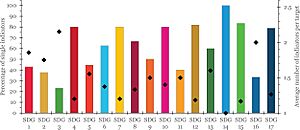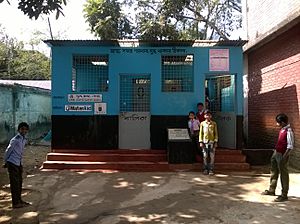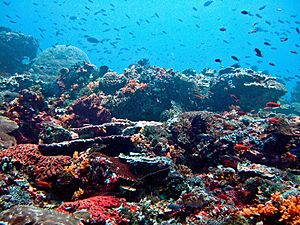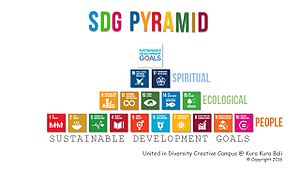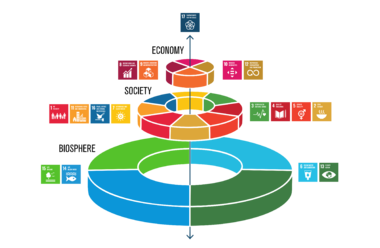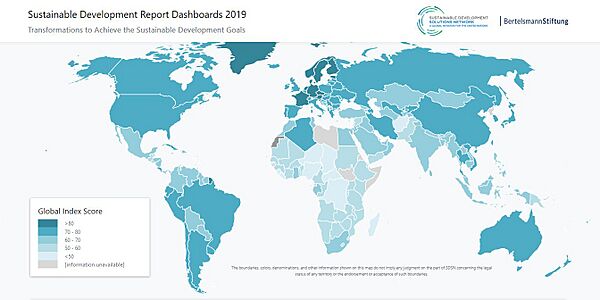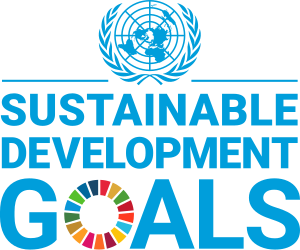Sustainable Development Goals facts for kids
Quick facts for kids Sustainable Development Goals (SDGs) |
|
|---|---|
 |
|
| Mission statement | "A shared blueprint for peace and prosperity for people and the planet, now and into the future" |
| Location | Global |
| Founder | United Nations |
| Established | 2015 |
| Disestablished | 2030 |
| Website | and |
In 2015, all the countries in the United Nations (UN) agreed on a big plan called the 2030 Agenda for Sustainable Development. This plan created 17 world goals known as the Sustainable Development Goals (SDGs). The main idea is to create "peace and prosperity for people and the planet." This means fighting big problems like climate change and protecting our oceans and forests.
The SDGs show how the health of our environment, our society, and our economy are all connected. The word "sustainable" is key. It means meeting our needs today without making it impossible for future generations to meet their own needs.
These goals are very ambitious. Reports show that reaching them by the 2030 deadline is a huge challenge. In fact, it's unlikely most of the goals will be met on time. Problems like growing inequality, climate change, and the loss of different types of plants and animals are slowing things down. The COVID-19 pandemic from 2020 to 2023 made these challenges even bigger.
Some goals work well together. For example, taking action on climate change (Goal 13) also helps with health (Goal 3) and clean energy (Goal 7). However, sometimes goals can conflict. For instance, growing enough food for everyone might be hard to do while also protecting the environment. Critics also worry that having 17 goals is too many, making them hard to track and focus on.
Contents
What Are the Sustainable Development Goals?
The Sustainable Development Goals are a set of 17 goals that act as a global "to-do list" for a better world. They were created by the United Nations to guide countries in tackling major world problems. The short titles for the 17 SDGs are:
- Goal 1: No Poverty - Ending poverty in all its forms everywhere.
- Goal 2: Zero Hunger - Ending hunger and making sure everyone has enough healthy food.
- Goal 3: Good Health and Well-being - Making sure everyone can live a healthy life.
- Goal 4: Quality Education - Providing a good education for all.
- Goal 5: Gender Equality - Achieving equality between men and women.
- Goal 6: Clean Water and Sanitation - Ensuring everyone has clean water and toilets.
- Goal 7: Affordable and Clean Energy - Providing reliable and clean energy for all.
- Goal 8: Decent Work and Economic Growth - Creating good jobs and growing economies fairly.
- Goal 9: Industry, Innovation and Infrastructure - Building strong infrastructure and promoting new ideas.
- Goal 10: Reduced Inequalities - Reducing inequality within and between countries.
- Goal 11: Sustainable Cities and Communities - Making cities safe, green, and good places to live.
- Goal 12: Responsible Consumption and Production - Using resources wisely and reducing waste.
- Goal 13: Climate Action - Taking urgent action to fight climate change.
- Goal 14: Life Below Water - Protecting our oceans and seas.
- Goal 15: Life on Land - Protecting forests, deserts, and wildlife.
- Goal 16: Peace, Justice, and Strong Institutions - Promoting peace, fairness, and strong government.
- Goal 17: Partnerships for the Goals - Working together to achieve all the other goals.
Key Principles of the SDGs
The SDGs are built on a few important ideas that make them different from past global goals.
Leave No One Behind
At the heart of the SDGs is a promise to Leave No One Behind. This means focusing first on the people and countries that are the most behind. It's about reaching the most vulnerable groups, such as people with disabilities, women and girls, young people, and the elderly. The goal is to make sure everyone benefits from progress.
For Everyone, Everywhere
Unlike the earlier Millennium Development Goals, which focused mainly on developing countries, the SDGs are for every country in the world. Rich and poor countries alike have to work on them. They cover all three parts of sustainability: the environment, the economy, and society.
How the Goals Work
To make the 17 big goals easier to manage, they are broken down into smaller pieces.
Goals, Targets, and Indicators
Each of the 17 goals has several smaller goals called targets. There are 169 targets in total. These targets are more specific. For example, a target for the "Clean Water" goal might be to make sure everyone has a safe toilet.
To measure progress on each target, we use indicators. An indicator is a piece of data that tells us if we are getting closer to the target. For example, an indicator for the toilet target would be "the percentage of people with access to a safe toilet." There are 234 official indicators used to track the SDGs.
A Closer Look at Some Goals
Goal 4: Quality Education
This goal aims to give everyone a fair and good education. Indicators track things like how many children attend and finish primary school. The data is checked to make sure that girls, children in rural areas, and poorer students are not being left behind. It also looks at whether schools have basic things like electricity, clean water, and toilets.
Goal 6: Clean Water and Sanitation
This goal is about making sure everyone has clean water to drink and a safe place to go to the bathroom. A 2017 report found that 4.5 billion people did not have a safely managed toilet. Another indicator tracks how much wastewater from homes and factories is treated before being released back into the environment.
Goal 14: Life Below Water
This goal is about protecting our oceans and the creatures that live in them. Current efforts are not enough to protect these important resources. Rising ocean temperatures and pollution are putting marine life in danger.
Challenges in Reaching the Goals
Achieving the SDGs is very difficult, and the world faces many obstacles.
Slow Progress and Setbacks
Most experts agree that the world is not on track to meet the goals by 2030. The COVID-19 pandemic was a major setback. It hurt progress on health, education, and reducing inequality. Other major problems, like climate change and the loss of biodiversity, also make it harder to move forward.
Difficult Choices
Sometimes, working on one goal can make another goal harder to achieve. This is called a trade-off. For example:
- How can we end hunger (Goal 2) without harming the environment (Goal 15)?
- How can we grow our economies (Goal 8) without causing more pollution (Goal 13)?
The SDGs don't always give clear answers on how to balance these competing needs.
Weak on Environmental Sustainability
Some critics say the SDGs don't do enough to protect the planet. While there are goals for climate, oceans, and land, there is no single, powerful goal for protecting the environment as a whole. The goals often focus more on economic growth than on staying within the Earth's natural limits. This could lead to more environmental damage in the name of development.
How Progress Is Monitored
Keeping track of progress on 17 goals across the whole world is a big job.
National Reviews
Countries can choose to report on their progress through Voluntary National Reviews (VNRs). In these reports, they share their successes and challenges with other countries. This helps everyone learn from each other.
Global Reports and Tools
Several organizations publish reports that track how the world is doing. The Global SDG Index ranks countries on their performance. There are also websites like the SDG Tracker that show data for all the indicators, making it easy for anyone to see where progress is being made and where it is lacking.
Every year, the High-level Political Forum on Sustainable Development meets at the UN. Government leaders and others gather to discuss progress and find ways to speed up action on the goals.
History of the SDGs
The idea of sustainable development has been around for a long time. In 1992, a big meeting called the Earth Summit was held in Rio de Janeiro. This meeting created a plan for protecting the environment while also helping people.
The SDGs were officially proposed in 2012 at another conference in Rio. After years of discussion involving countries, experts, and citizens from around the world, the final 17 goals were created. On September 25, 2015, all 193 countries in the UN General Assembly officially adopted the "2030 Agenda for Sustainable Development," which includes the 17 SDGs.
Images for kids
-
Katherine Maher, then-Executive Director of the Wikimedia Foundation, talks about "The role of free knowledge in advancing the SDGs" in Stockholm, 2019.
See also
 In Spanish: Objetivos de Desarrollo Sostenible para niños
In Spanish: Objetivos de Desarrollo Sostenible para niños
- SDG Publishers Compact
- List of Sustainable Development Goal targets and indicators
- Political representation of nature


